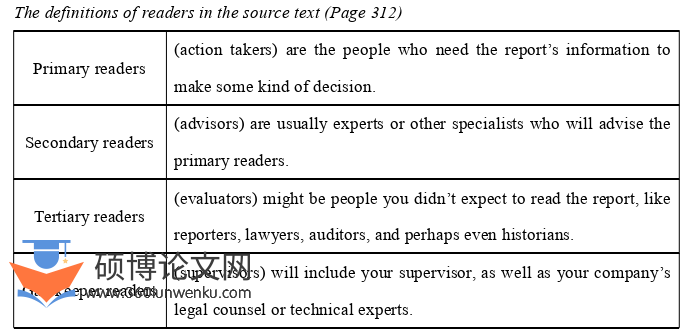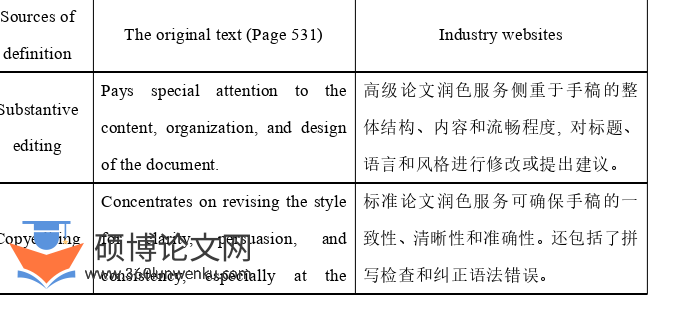本文是一篇英语论文,通过本次实践,希望可用性能为判断翻译作品能否实现用户可用、评估其是否满足用户实际需求提供方法。同时译文可为技术传播、技术写作的学习和实务提供参考。
1 Introduction
1.1 Introduction to the Translation Task
Technical Communication Today,written by Richard Johnson-Sheehan,has twenty-onechapters.The author made efforts to stress the importance of innovation and entrepreneurshipand showed the readers how to carry out efficient technical communication in the workplace.As his saying(Johnson-Sheehan 2018),it is provided for instructors and administrators toteach courses and assess student learning.The task of this translation practice is selected fromChapter 12 to Chapter 21,which contains the last three parts of this book:planning and doingresearch;drafting,designing,and revising;connecting with clients.
According to the Bureau of Labor Statistics,technical communication employment isprojected to grow 11%from 2016 to 2026,faster than the average for all occupations(https://www.stc.org/about-stc/defining-technical-communication).The increased demand fortechnical communicators in the workplace underscores the need for China to prioritize thedevelopment of technical communication curricula and the incorporation of high-qualityforeign teaching materials.Nowadays,language service providers are required to language,technology,culture,and management,which highlights the benefits of translating this book,Technical Communication Today.
To be a preeminent technical communicator in the professional workplace,readers cangrasp writing skills and improve their critical thinking ability under the guidance of this book.How to achieve efficient use and effective comprehension by users is the critical factor inmaintaining the purpose of the original text after translation.The three perspectives ofusability:stylistic factors,communicative function,and physical presentation are analyzed toachieve this goal.

英语论文怎么写
........................
1.2 Linguistic Features of the Source Text
According to the linguistic features of the source text,Technical Communication Todayis categorized as an informative text in terms of text type(Newmark 2001).The text typefocuses on conveying the information to specialized readers,taking objective facts as thecenter and truth as the first choice,and being impersonal as well as precise(Wang 2023).Besides,the book serves as a tool for people to use for reference in their work and research,which is in line with the common characteristics of informative text.
Investigating the acceptance of linguistic elements can benefit user-centered translationin concrete ways,since the target audience’s preferences let the translator determine whatlinguistic and stylistic choices are reliable and fluent from the users’point of view,thusimproving the text’s readability and comprehensibility(Suojanen et al.2015:114).Onlytranslators find out the linguistic features and styles of the source text can they formulate themost appropriate translation strategies.The translator read the original text several times,thensummed up the following linguistic features:
At the lexical level,Technical Communication Today mainly emphasizes practicality.Itcontains specific terms,specialization of common words,abbreviations,and numeral words.The verbs placed at the beginning of sentences aim to increase the amount of conciseinformation contained and enhance the objectivity and rigor of the presentation.
.......................
2 Translation Process Description
2.1 Pre-translation Preparation
Technical communication is a new way of information exchange.Therefore,beforetranslating the book on how to learn technical communication,the translator first looked upthe background knowledge about the relevant texts of technical communication,made fullpreparations for the tools used in the translation process,and arranged the translation scheduleto efficiently complete the translation of the informative text.
(1)Preparation of background information
Owing to the linguistic features,Technical Communication Today(ESP,English forspecific purposes)shall ensure that the source language content is analyzed to ensure efficientand effective performance of the translation project.These reference materials are necessaryfor ESP to support a more comprehensive understanding of the main topic of the text:technical communication.
To gain a deeper insight into the source text,thorough preparations were meticulouslycarried out beforehand.The translator searched the relevant information about technicalcommunication on the Internet by using keywords like“technical communication”,and“technical writing”,from the perspectives of industry,cultivation of technical communicationtalents,and guidelines for technical communication style.
The translator prepared the related background materials through some websites,such as:tc world China(http://www.tcworld-china.cn),China Association for Standardization(http://www.china-cas.org),Society for Technical Communication(http://www.stc.org)and so on.The translation service provider should make the project registration to record the details,which include the composition of the translation service provider,source and target language(E-C),date of receiving the source text and the deadline for translation,some parallel textssuch as Handbook of Technical Writing written by Alred,the title and main content,purposeand use of the translation.
..........................
2.2 Translation Process
The second process involved four steps:translation,editing,third-party evaluation,proofreading,and final verification.
(1)Translation
The translator should translate the text according to the purpose of the translation project,and adapt the translation to the conventions and relevant norms of the target language.In thecourse of the translation process,the translator provided a service that complied with theInternational Standards.
In the beginning,the translator read the original materials,got a clear understanding ofthe content of the original text,and recorded the keywords in each chapter,which was veryhelpful for the translator’s further translation work.Translating the source text adhering to theguidance of the translation usability theory,then the translator recorded the problems anddifficulties in the translation process and later discussed how to solve them to achieve themaximum usability of the translation.
(2)Editing,third-party evaluation and proofreading
After English was converted into Chinese,the translator made a self-revision of thetarget text,made some necessary corrections before delivery,and reviewed the problems ofomitted translation,grammar,mangled translation,missed translation,format,and the writing style of the translated version,and so on.Then the translated text was evaluated by thesupervisor who meets the requirements of professional competencies.The proofreading wascentered on the readability of the target text,the translator didn’t refer to the original textwhen reading the translated version,so whether the language of the text conforms to theChinese expression can be observed.Any errors or other issues affecting the target language’squality should be corrected,and the process was repeated until the reviser and translator weresatisfied.
........................
3 Usability and Translation ................... 10
3.1 Introduction to Usability of Translation ........................ 10
3.2 Realization of Usability in Translation ........................... 11
4 Case Analysis ......................... 14
4.1 Realization of Language Readability in Translation ....................... 14
4.1.1 Realization of Accurate and Concise Language Features .......... 14
4.1.2 Realization of Chinese Logical Structure in Language ............. 19
5 Conclusion ............................... 36
4 Case Analysis
4.1 Realization of Language Readability in Translation
Many specific language standards and measurement systems have been developed toevaluate the readability of texts.The traditional readability indicators are based on themeasurement of the length of sentences or words(Suojanen et al.2015).Readability issummed up as the characteristics of the language itself,which is affected by stylistic factorssuch as word choice,argumentation structure,the rhythm of the text,smooth transitionbetween text parts,active versus passive voice,and reader orientation.This section willdiscuss how to realize the translation readability in language,which will be analyzed fromthree perspectives of language:accurate and concise language features,logical structureconforming to Chinese habits,and standard writing style.
4.1.1 Realization of Accurate and Concise Language Features
The main purpose of Technical Communication Today is for readers to use in theworkplace,and the language should be concise and clear.The word choice:specialized termsin the field of technical communication and personal pronouns,these two points are actuallyto be found in the translation problems of language accuracy and conciseness.Analyzing thedifferences in language features is a critical measure to ensure the translation effect betweenEnglish and Chinese.

英语论文参考
...............................
5 Conclusion
To sum up,the translation of information text should be carried out for the purpose ofusing technical documents.In fact,it aims to give full play to achieve the usability of thetarget text and let users complete their tasks.This translation practice thought about how torealize the usability of the text,summarized the problems that need to be solved in thetranslation process,and applied relevant translation guiding principles and strategies topractice,which were very important to achieve semantically accurate translation.
Firstly,a thorough understanding of the source text was the first step in translation.Thenthe author understood the content,purpose,and genre of this book,and looked for paralleltexts with similar background knowledge on the website.The original material TechnicalCommunication Today is different from other information texts,which is an instruction toguide readers to use,and the effect of“use”is paid much attention to achieve.As for thetranslator,this kind of informative text should focus on“user-centered”translation,regard theuser’s actual operation as the first translation criterion,and keep the translator invisible.Conforming to its text features,only by maintaining the usability of translation can theaccuracy of the text translation be realized and the translation quality be guaranteed.
Secondly,the report discussed the translation practice from three perspectives:languagereadability,users’comprehensibility,and physical presentation,which are the fundamentalconcepts defining the usability of texts.In terms of readability,the translator analyzed theinfluence of English(hypotaxis)and Chinese(parataxis)to ensure logical structure in linewith Chinese habits and used a style guide to achieve a concise writing style instead ofquantitative analysis.As for the users’comprehensibility,their personal cognition andinformation need focus were emphasized to convey the communicative function,such as theIconic Linkage.The physical presentation concentrates the visual elements of a book more infact,no matter what the principles or guidelines used in the translation process,like the CY/T123-2015,therefore the written content can be perceived intuitively and linked to aestheticpreferences.
reference(omitted)
